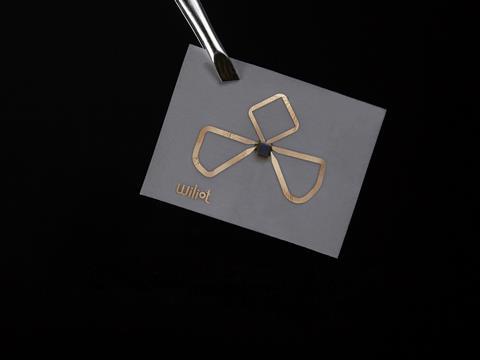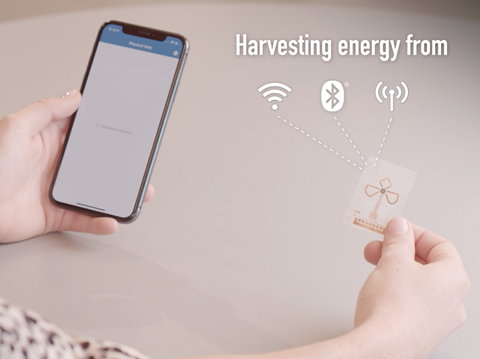
Anticipating a future where paper thin battery-free Bluetooth sensors connect people with packaging and products, Wiliot and Avery Dennison discuss with Packaging Europe the potential of the first battery-free Bluetooth® sticker sensor tag, which has recently raised a $30 million series B for a total of $50 million in funding.
Steve Statler, SVP Marketing & Business Development, Wiliot explains the journey so far to Libby White, and Francisco Melo, VP & GM, Global RFID, Avery Dennison outlines why they have invested in this potentially ground breaking technology.
How long has this been in development- can you tell me about the process so far?
SS: Wiliot has been working on this technology since its inception in 2017. We’re at a point now where we have a working concept, and this funding will help us take the vital next step towards full commercialisation.
That’s one area in which we see Avery Dennison’s participation in the round as a strategic investor and partner as extremely exciting. The manufacturing expertise within the organisation when it comes to making packaging and labelling innovation commercially viable at scale will certainly help us drive forward towards our goal.
Amazon Web Services (AWS) Investment Arm, Samsung Venture Investment Corp. and Avery Dennison have all invested. Can you tell me their interest in this solution and how these companies may be looking to apply the technology?
FM: The fact this sensor tag communicates via the Bluetooth standard makes it very interesting - it delivers functionality outside the realm of RFID tags, enabling seamless interaction for consumers using their smartphones rather than requiring specialist hardware. Understanding how consumers use and interact with products beyond the point of sale - for some time a closed door to brands - is a vital part of enabling full end-to-end supply chain insight, and this technology has the potential to complement existing and future RFID- and QR-based solutions.
And, of course, sustainability is increasingly becoming a top priority for brands and consumers alike. The fact that the Wiliot Bluetooth sensor tag runs off energy harvested from ambient radio frequencies, rather than an on-board battery, not only means that it can in theory run indefinitely - significantly reducing cost and waste - but also that it can be disposed of much more sustainably.
Can you please discuss the potential of this technology- what are its main benefits?
SS: The biggest benefit of what we have created here is that it does everything it does without relying on an on-board power supply, instead drawing on power from ambient radio frequencies. This gives our sensor tag unlimited lifespan, which opens up different applications and significantly improves sustainability.
FM: Additionally, operating via Bluetooth means that products and packages bearing these tags can easily interact with consumers using a device they always have with them - their smartphone. This makes it potentially an excellent complementary technology to existing and future RFID and other Intelligent Labels solutions.
How does it disrupt the current landscape with regards to innovation, design and technology?
FM: This is the first Bluetooth sensor tag to get down to this small footprint - the size and thinness of a postage stamp. That’s in large part because it runs off energy harvested from ambient radio frequencies rather than off an on-board battery - and it’s significant not just because it makes the sensor easier to unobtrusively apply to products and packaging, but also because the theoretically unlimited lifespan of the tag reduces cost and waste and the simplicity of the materials creating a more sustainable solution.
Can you tell me how it compares to alternatives on the market with regards to material waste/ durability/ possibilities for recycling?
SS: Mounted on paper tags, or on cardboard or metal packaging, most of the product can be recycled. The antennae are made from aluminium, which is a completely biodegradable.
The biggest advance in sustainability comes from removing the need for an on-board power supply, so there are no battery materials to dispose of, which are much harder to recycle.
How vital is it to remove the need for a battery in this kind of device?
SS: We believe that creating battery-free, low-cost electronics is absolutely key to future IoT systems, and in particular to integrating items that are not inherently digital into the IoT.
Removing the battery and powering the tag by harvesting energy from ambient radio frequencies not only reduces the size and practicality of the tag, but also greatly improves its sustainability.

I'd like to hear about the solution's possibilities for real-life applications within the packaging sphere.
SS: Bluetooth tags can be embedded into consumer products and packaging at the production phase, to facilitate real-time tracking throughout the manufacturing, distribution, and retail process, being scannable for critical information at every stage from the warehouse to the store.
We see apparel as being the most likely sector for early adoption - the tag could be embedded in the garment care label to enable tracking through the supply chain and also communication of vital information (such as care instructions, wardrobing recommendations, or proof of authenticity) in a digital format long after the printed label has faded or other assets been lost or thrown away.
FM: This technology has wide cross-sector applicability. The time and temperature sensing capabilities, for instance, mean that distributors and retailers of fresh food or certain pharmaceutical products can accurately monitor how long items have been stored outside of their optimum temperature, and whether they need to be withdrawn from sale as a result.
What does the tag offer with regards to traceability? What are its benefits compared with other technologies on the market?
SS: It enables much more accurate traceability of products at the item level, both through the supply chain and when they are in consumers’ hands.
At the consumer end, for example, it enables consumers to check whether or not the product they have is the genuine article - a significant concern when the economy around counterfeit goods is so large. It also helps track lost or stolen products, without having to apply a dongle with limited battery life.
What are the possibilities for consumer-engagement? How can brands leverage its potential?
SS: The consumer engagement opportunities are extremely wide-ranging: from the simple - such as providing digital access to vital information such as garment care instructions, an appliance user manual, or confirmation of authenticity - to the more sophisticated, such as enabling reordering of products or detecting when you’ve put something red in the wash with your whites and stopping the machine from running.
Is this the future for connecting products (and brands to the consumer) through packaging? How may other cutting-edge technologies be able to interact with this device? (for example smart fridges/ washing machines?)
SS: We’re all too familiar with the notion of the smart fridge that alerts you when you’re running out of milk, or even provides a prompt to add more to your online shopping list. That sort of thing is certainly possible, thanks to the pressure-sensing capabilities.
But imagine your washing machine alerting you - and even refusing to start a wash cycle - because you put something bright red in with your whites. With the level of product information stored and transmitted by this tag, and the ability to communicate with smart appliances over Bluetooth, that’s very much the sort of integrated application of the technology we are looking at. As the IoT expands and more and more devices are connected the more they will be able to interact with this type of device.
As the chip is able to draw power from WIFI networks by placing it near smart fridges it can tell you what food you have available and even in the future provide potential recipes with what is in your fridge at that time. For clothes it can tell your washing machine if you might be mixing colours and whites and so stop you from turning your white clothes pink.










